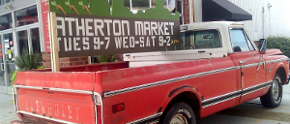Healthy Milk and More : Backyard Goats
 Saturday, February 16, 2013 at 2:08PM
Saturday, February 16, 2013 at 2:08PM
Why keep goats? Although their most popular uses range from high quality milk and lean meat, to fiber for spinning textiles, to clearing brush, goats can even be used as pack animals on hiking trips, or even hitched up for light duty tasks around the homestead. They’re easy to transport and handle, inexpensive to maintain, and don’t take up a lot of space.
There are 200+ breeds of goat in the world, each with its own useful traits. Some are more productive for meat, while others make better milk or hair fiber for spinning.
Goats are most commonly used for milk in the urban backyard setting. In the US there are six main dairy breeds ; Alpine, Lamancha, Nubian, Oberhasli, Saanen, and Toggenburg. A full sized doe weighs between 120-135 lbs, and can produce up to 90 quarts of fresh milk every month that you can drink or use to make yogurt, cheese, ice cream, or even soap.
While cow milk is more popular in the US, goat milk is more widely consumed in the rest of the world. Like all milk, goat milk is made up of about 87% water, and 13% solids including lactose, milk fat, proteins, and minerals.
Not ready for a couple of 135 lb. dairy goats in your backyard? Miniature goat varieties are about a third the size of full sized goats, and thus eat less and require less space and a smaller housing structure. Of course, smaller size means less milk, but the milk that miniature goats produce is higher in fat and therefore tastes sweeter. The two miniature goat breeds are African Pygmy and Nigerian Dwarf.
In terms of shelter, goats are pretty low maintenance, requiring only a well ventilated shelter that offers protection from rain, sun, wind and snow. Each full sized goat requires 15 square feet of covered area and 200 square feet outdoors, while miniature goats only need 10 square feet of covered shelter and 130 square feet outdoors. Goats are social animals, so you’ll need at least two, and remember that you’ll need a sturdy fence as they’re prone to escaping under, over, or through inadequate fencing.
Goats are ruminants - hoofed animals with four part stomachs - and belong to the same Bovidae family that includes cattle, buffalo, and sheep. They’re opportunistic eaters, meaning they graze pasture and also browse woodland. If your goat can at least harvest some of its own food by grazing or browsing, it’ll cost less to feed in hay and ration.
Live in the Carolinas and need a high quality backyard goat shelter? You’re in the right place. Call 704.568.8841 or write hello@microfarmgardens.com to get started.








